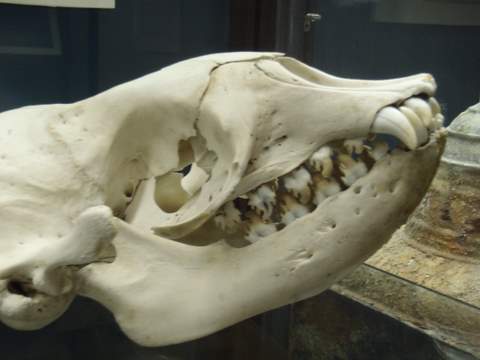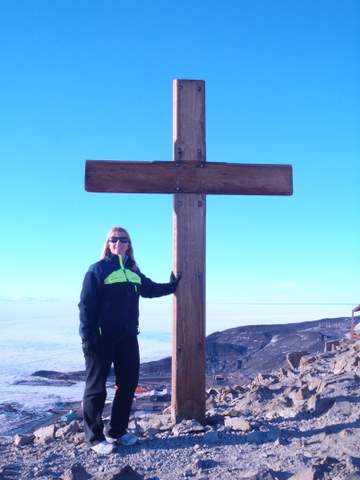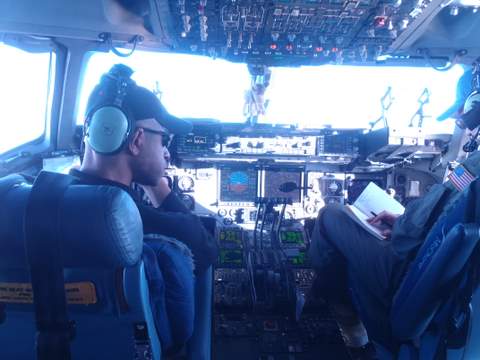After checking in our bags at the transit center, we had about 12 hours to spend at McMurdo Station before our scheduled meeting time at 1:30 am. We were assigned shared rooms in the station dormitories, but most of us only used the rooms to store our carry on bags while we toured the station. McMurdo Station is the largest scientific base in Antarctica and it resembles a small town, complete with a dining hall, coffee house and wine bar, health clinic, recreation facilities, bowling alley, greenhouse, post office, gift shop, chapel, and a large lab.
We were lucky enough to get a tour of Crary Lab, a state-of-the art laboratory which houses scientists working on a wide variety of research. This summer season, research projects in and around McMurdo Station included studies of solar winds, upper atmospheric observations, cosmic rays, middle atmosphere chemistry, meteorites, hyperarid soils, fossils, glaciers, ice cores, ozone, Weddell seals, marine invertebrates, sea ice, and more!
 Crary Lab had some wonderful displays of Antarctic animals. This is an Emperor penguin and its chick.
Crary Lab had some wonderful displays of Antarctic animals. This is an Emperor penguin and its chick.
 The skull of a crabeater seal clearly shows its unique teeth, perfectly adapted for straining krill from the water.
The skull of a crabeater seal clearly shows its unique teeth, perfectly adapted for straining krill from the water.
We ate dinner, served cafeteria style, in the large dining hall. After 6 weeks on the Oden, sharing meals in the cozy dining mess, McMurdo's dining hall seemed so busy, so loud, so overwhelming that we hardly spoke during our meal, instead just sitting quietly and taking it all in. Now the magnitude of the ship experience was starting to sink in. I had just left a ship that was my home for 6 weeks, with no outside contact (other than phone calls and emails), and I wasn't ready to rejoin the outside world yet!
After dinner, I was in the station store, shopping for last minute souvenirs, when I heard someone call my name. It was Lesley Urasky , another PolarTREC teacher! Lesley had been at McMurdo for a few days, awaiting a flight out, and now she was scheduled to fly out with us. We decided to tour anouther McMurdo landmark, Scott's Discovery Hut. Scott's Hut is located at the tip of Hut Point at the entrance to the ice pier. The hut was built in 1902 as part of Scott's Antarctic Expedition. Other explorers also used the hut, including Shackleton in 1908, and Scott again in 1911, just before his tragic death after reaching the South Pole in January, 1912. We were disappointed when the tour guide failed to appear to open the hut as promised, so we could only view it from the outside. I will just have to see the inside of the hut the next time I visit Antarctica!
 Scott's Discovery Hut, built in 1902, stands on Hut Point below McMurdo Station.
Scott's Discovery Hut, built in 1902, stands on Hut Point below McMurdo Station.
With a few hours left before our departure, most of the Oden scientists met in the coffee house/wine bar. We were joined by many of the scientists from the NB Palmer, which had just docked at the ice pier.
 Anne Marie at McMurdo station, above the ice pier where the NB Palmer was docked.
Anne Marie at McMurdo station, above the ice pier where the NB Palmer was docked.
Sea ice team member David and I decided to climb Observation Hill (Ob HIll), a 230 meter tall volcanic cone that towers above McMurdo Station. It was a strenuous hike to the top, but the views were unbelievable! At the top is a cross placed there to honor Scott and the 4 other men who died with him on their way back from the South Pole. David helped me fly the flags one last time, and then we headed back down the steep slope.
 Observation Hill, or Ob Hill, is a volcanic cone, 230 meters tall, that towers over McMurdo Station.
Observation Hill, or Ob Hill, is a volcanic cone, 230 meters tall, that towers over McMurdo Station.
 The view from Ob Hill, with the NB Palmer at the ice pier, the lab, the blue Building 155, and the frozen sound with the Oden's path broken through the ice.
The view from Ob Hill, with the NB Palmer at the ice pier, the lab, the blue Building 155, and the frozen sound with the Oden's path broken through the ice.
 Anne Marie stands next to Scott's Cross at the top of Ob Hill. It is a memorial to Robert F. Scott and his 4 party members who died while returning from the South Pole in 1912.
Anne Marie stands next to Scott's Cross at the top of Ob Hill. It is a memorial to Robert F. Scott and his 4 party members who died while returning from the South Pole in 1912.
 The flags flew at the top of Ob Hill, high above McMurdo Station.
The flags flew at the top of Ob Hill, high above McMurdo Station.
We found many of our shipmates having a midnight snack in the dining hall, then it was time to collect our carry-on bags and head to the transit center.
At the transit center, we pulled on our ECW (Extreme Weather Clothing) - insulated pants, huge white "bunny" boots, and "Big Red' parka worn over the clothes we already had on. Then we loaded into 2 different vehicles to carry us the 25 km to the Pegasus ice runway. "Ivan" the Terra Bus is a huge snow bus, and I rode in a Delta transport, a tractor-trailer transport that moved slowly and bumpily over the snow road. By now it was 2:00 am and we had been up since 4:00 am the morning before, so we all fell asleep in the Delta trailer.
 Anne Marie rode in a Delta transport over 25 km of ice road to the Pegasus ice runway.
Anne Marie rode in a Delta transport over 25 km of ice road to the Pegasus ice runway.
At about 3:00 am, we arrived at the ice runway. It was basically a few trailers and small planes parked on the snow-covered field. We were directed to a small trailer lined with rows of chairs, our "airport gate" where we would wait for the C17. And we received word of another rescheduling - out plane was not leaving at 4:00 am, but now 6:00 am. So those of us lucky enough to have a chair hunkered down and tried to sleep, while the rest of the group milled around outside, talking and waiting for the plane to arrive.
 Anne Marie Wotkyns waits for the C17 at the Pegasus ice runway.
Anne Marie Wotkyns waits for the C17 at the Pegasus ice runway.
I was asleep when the C17 landed from New Zealand, but we were all quickly roused and herded outside where we lined up in a long line of "Big Red" parkas. We walked across the frozen airfield and boarded the huge gray plane.
 The passengers finally boarded the C17 plane at 5:00 am.
The passengers finally boarded the C17 plane at 5:00 am.
The C17 is a National Science Foundation chartered plane, operated by the US Air Force Air Mobility Command. It had a cargo section in the back where pallats of cargo and our luggage were stored. The rest of the open cabin was lined with a row of small webbed seats facing in, and another center row, facing out. There was a small VIP section of traditional airline seats in the front of the cabin. And, unlike a traditional plane, there were no regular windows. There were two small windows on each side of the plane, and during the flight, we lined up to take pictures out the tiny windows. The crew handed out earplugs, which we wore the entire flight because of the very loud engine noise. Any conversaion was impossible.The C17's takeoff was similar to a regular airplane, but it was strange not being able to look out a window.
 The C17 is a large cargo plane, designed for transport of cargo, not passenger comfort.
The C17 is a large cargo plane, designed for transport of cargo, not passenger comfort.
 Anne Marie Wotkyns and other passengers on the C17 bound for New Zealand.
Anne Marie Wotkyns and other passengers on the C17 bound for New Zealand.
About an hour into the flight, we were invited to line up and take turns visiting the cockpit. From there I could clearly see the edge of the fozen continent, and when I got my turn at the small window, I could see Drygalski's Ice Tongue, a seaward extension of the David Glacier, which extends nearly 50 km out into the Ross Sea.
 The Air Force pilots invited us to visit the cockpit for a spectacular view of the continent and the Southern Ocean below us.
The Air Force pilots invited us to visit the cockpit for a spectacular view of the continent and the Southern Ocean below us.
 Drygalski Ice Tongue is a 50 km long extension of the David Glacier.
Drygalski Ice Tongue is a 50 km long extension of the David Glacier.
The rest of the 5 1/2 hour flight passed quickly as we dozed through the loud rumbling and mild turbulence as we flew towards New Zealand. It was very weird coming in for a landing, with no idea when the wheels would touch down. The landing was smooth and soon we were off the plane and boarding a shuttle bus to take us to the terminal.
 Room 14's mascot Pascy enjoys his ride on the C17, headed for Christchurch, New Zealand.
Room 14's mascot Pascy enjoys his ride on the C17, headed for Christchurch, New Zealand.
We had arrived in Christchurch, New Zealand at noon, on January 18, but it was still a long way from home!
Lesson Learned: Not all plane travel is created equal.

